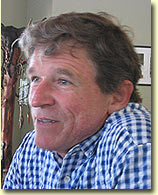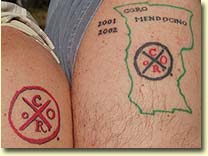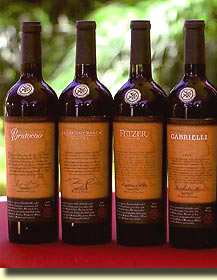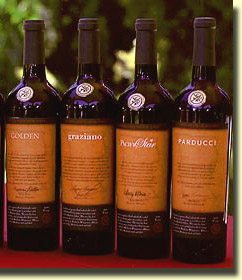|

 
by Carolyn Tillie
One
of the major tricks of getting any type or style of wine known is
developing a "schtick" or a unique selling characteristic that will set
it apart from all others. The Meritage
Association did it very successfully in 1988 by actually
creating a new word ("Meritage" is merely a conjunction of the words
merit and heritage) so that folks would know that a mere Red
Table Wine was something special, something different. In fact a
Meritage IS just a blend of Bordeaux varietals and if John-Q-Winemaker
wants to put that special word on his bottle, then he basically agrees
to give the association a dollar a case (up to a certain amount) for the
marketing honor. Some folks don't want to bother with fancy monikers and
end up using some of the age-old terms like Claret or Cuvée to denote
their blends. Other wineries make up their own special names for their
blends; Duckhorn has its
Paraduxx,
Gundlach Bundschu has its
Bearitage (with tongue firmly in
cheek in reference to the Meritage Association), and
Franciscan has its
Magnificat, just to name a
few.
 So
it was with tremendous interest that I accepted an invitation by the
Mendocino Winegrowers Alliance
to learn about
Coro
Mendocino, a new blend and a new breed of wine. The press
release is pretty straightforward: "Coro Mendocino is a unique
collaborative effort by Mendocino winemakers to create a class of
ultra-premium wines that showcase the rich heritage and unique
characteristics of Mendocino County." So
it was with tremendous interest that I accepted an invitation by the
Mendocino Winegrowers Alliance
to learn about
Coro
Mendocino, a new blend and a new breed of wine. The press
release is pretty straightforward: "Coro Mendocino is a unique
collaborative effort by Mendocino winemakers to create a class of
ultra-premium wines that showcase the rich heritage and unique
characteristics of Mendocino County."
Yeah, well... what the heck did all that mean? What ARE the unique
characteristics of Mendocino County and who knew there was a rich
heritage up there?
Obviously there were many who realized what a significant goldmine
Mendocino had the potential to become. Wine production goes back to the
19th century when failed gold prospectors started planting grapes to
produce the wines they knew well from their European roots. An added
advantage was the fact that the spread of phylloxera at the end of the
19th century did not travel as far north as Mendocino, sparing the bulk
of vineyards. Then, in the 1950s, Fetzer
Vineyards put the county on the modern wine map, starting
with just over 700 acres and ultimately becoming the sixth larger
producer of wines in the United States.
 Coro
comes from the Italian and Spanish word for "chorus." And while not
noted on their website, Coro was really the brainchild of
Paul Dolan (left),
a fourth generation vintner who is an icon in the wine world, not only
for putting Fetzer on the map, but also for much of his environmental
philosophies, which are changing the industry ecologically for the
better by spearheading organic systems. It was while Dolan was president
of Fetzer Vineyards that he considered the fact that the Mendocino wine
community was in need of a draw. He and a handful of other local
winemakers had some brainstorming sessions and took stock of what they
were already doing that was great, what asset they all held in common,
and how they could marry these facets together into a promotable
commodity. Coro
comes from the Italian and Spanish word for "chorus." And while not
noted on their website, Coro was really the brainchild of
Paul Dolan (left),
a fourth generation vintner who is an icon in the wine world, not only
for putting Fetzer on the map, but also for much of his environmental
philosophies, which are changing the industry ecologically for the
better by spearheading organic systems. It was while Dolan was president
of Fetzer Vineyards that he considered the fact that the Mendocino wine
community was in need of a draw. He and a handful of other local
winemakers had some brainstorming sessions and took stock of what they
were already doing that was great, what asset they all held in common,
and how they could marry these facets together into a promotable
commodity.
The asset in common? Zinfandel, the ubiquitous California grape. There
is no doubt that Zinfandel is the varietal that put California on the
wine-making map (way back in 1889, bottles of California Zinfandel wine
were winning awards at the Paris exposition, long before the now famous
1976
Judgment of Paris!), and with its 18,000-plus acres of vineyards,
Mendocino County is certainly contributing its fair share of Zinfandel
to the marketplace. The next question was what could be done with
Zinfandel that was both remarkably different in the marketplace, and
would also provide the winemakers their freedom in creation?
(Publisher's Note: George Taber's personal account of the
tasting in Paris will be published in Sept., 2005. Order your
advance copy by clicking on the link at the left.)
The decision (after much debate and discussion) is
Coro Mendocino. Having Zinfandel as
their base, each participating winery has the freedom to create a blend
of their own design. There are, of course, guidelines; only Mendocino
fruit can be used, Zinfandel must comprise 40% to 70% of the final
blend, and the wines must pass a severe tasting panel of five judges
(other fellow wine-makers). There are other considerations as well - the
wines can only be produced by Mendocino County bonded wineries, the
finished product sells for $35.00, and they all share the same size and
shaped bottle and label design, with each winery's logo as part and
winemaker's name as part of the artistry. At its inception with the 2001
vintage, only five wineries participated, then seven, and now, in 2005,
there are nine wineries producing a Coro blends with more local
producers showing interest.
The varietals used and production amounts are one of the differing
factors in Coro's development. Some wineries specialize in Rhone
varietals like Grenache, Carignane, and Syrah while other wineries are
growing mostly Italian grapes like Dolcetto, Sangiovese, or Barbera.
These are considered the Second Tier varietals and the percentage of any
one of these grapes must not exceed that of the Zinfandel, which must
remain the wine's major component. Other Second Tier varietals that are
considered acceptable include Petite Sirah, Charbono, and Primitivo.
What about Cabernet Sauvignon or Merlot? Well, the winemakers are given
a 10% leeway in developing their blends and some might introduce those
flavors into their wine, but the general consensus is that "these grapes
don't really play well and can overwhelm" those in the Second Tier
profile. For a small winery like Golden Eagle, their production level of
the Coro blend was only 76 cases while the Fetzer behemoth was able to
produce 500 cases.
The judging aspect is another factor that is decidedly unusual.
Hearkening back to that Meritage, just remember that any winery that
wants to pay for the privilege and uses the correct grapes can use the
Meritage word. Not so with the Coro moniker; the Panel of Five (three of
which MUST be from participating wineries), taste the wines throughout
their production and thus carefully scheduled tastings occur. Around the
First of June, an initial tasting of a winemaker's blend is done. It is
here that first impressions are made and suggestions given. A winemaker
might go back and tweak his or her blend to enhance or subdue flavors
for optimum quality. Two weeks later, after some fine-tuning, a second
tasting is done and final blends might be established.
 Six
months later (after the wines have seen 14 months in the barrel), a
second thorough review and tasting is done, but this time a chemical
analysis is also performed. Very specific parameters have also been
established regarding alcohol, pH, and total acidity (TA) levels are
also part of the strict guidelines and it is the winemaker's
responsibility to keep within the framework.
Casey Hartlip (left, with Peewee) of
Eaglepoint Ranch Winery sat on the
2002 vintage panel, and recalls, "In a blind tasting, I rejected my own
wine and had to go back and do some re-blending to bring it up to the
quality that was being produced by everyone else." (photo
courtesy of Eaglepoint Ranch Winery) Six
months later (after the wines have seen 14 months in the barrel), a
second thorough review and tasting is done, but this time a chemical
analysis is also performed. Very specific parameters have also been
established regarding alcohol, pH, and total acidity (TA) levels are
also part of the strict guidelines and it is the winemaker's
responsibility to keep within the framework.
Casey Hartlip (left, with Peewee) of
Eaglepoint Ranch Winery sat on the
2002 vintage panel, and recalls, "In a blind tasting, I rejected my own
wine and had to go back and do some re-blending to bring it up to the
quality that was being produced by everyone else." (photo
courtesy of Eaglepoint Ranch Winery)
 Hartlip
is one of Coro Mendocino's more enthusiastic winemakers. He, along with
Fred Nickel of
Brutocao Cellars have gone to the extreme of getting
tattoos in devotion to the Coro brand; Fred, with a more benign Coro
logo, but Casey's with the logo, an outline of the Mendocino county
boundaries, and subsequent years that his wines are accepted. What
happens if the panel rejects his blend? "I haven't decided what I'll do
then," Hartlip explained. "Maybe have the year tattooed and then crossed
off... But I don't want to think about that!" Hartlip
is one of Coro Mendocino's more enthusiastic winemakers. He, along with
Fred Nickel of
Brutocao Cellars have gone to the extreme of getting
tattoos in devotion to the Coro brand; Fred, with a more benign Coro
logo, but Casey's with the logo, an outline of the Mendocino county
boundaries, and subsequent years that his wines are accepted. What
happens if the panel rejects his blend? "I haven't decided what I'll do
then," Hartlip explained. "Maybe have the year tattooed and then crossed
off... But I don't want to think about that!"
During my weekend with these Mendocino winemakers, there was one other
astonishing trait that is rarely seen, a true camaraderie amongst
professionals. The Coro blends are scheduled for release each year
during the annual Mendocino Wine Affair, held this year on the weekend
of June 12th. A magnum of each Coro blend was put into a specially
designed wooden case and along with the collection, the auction item
included a tattoo session with Hartlip and Nickel. But to sell their
particular auction lot, these Brothers of Zin wrote and performed a
special song, encouraging an increase in bidding and the general
goodwill of the community. It was something I wish their Napa
counterparts could have witnessed...
Golden
Vineyards 2002 - 42% Zinfandel, 40% Syrah, 18% Petite Sirah
Inky red with spicy dark plum and fresh violet tones, layered with some
dried twig. Initial mouth entry was lighter than the aromas indicated,
displaying red plum and cherry with an herbal finish.
Brutucao Cellars
2002 -
48% Zinfandel, 32% Syrah, 16% Primitivo, and 4% Sangiovese. Dried floral
aromas with a smooth mouth entry; the mid-palate showed slight dry
characteristics, but brightened on the finish to show some enticing
cherry qualities.
Fetzer Vineyards
2002
- 40.7% Zinfandel, 33.3% Syrah, 21.3% Petite Sirah, and 4.7% Grenache
Noir. Decidedly fruit-forward with an easy cherry front and developed,
dark raspberry both on the end of the aromas and in the finish.
Pacific Star Winery
2002
- 40% Zinfandel, 30% Petite Sirah, 15% Syrah, 5% Charbono, 5% Barbera,
and 5% Pinot Noir. Intensely elegant fruity nose with floral tones that
tease and entice. The fruit continues with the first taste and expands
to demonstrate dried roses and cherry blossom with a lingering spicy
finish.
Dunnewood Vineyards 2002 - 44% Zinfandel,
22.4% Charbono, 7.3% Cabernet Sauvignon. A bit darker and more rustic
than the previous tastings with black plum and dark spice. Drier in the
middle, and showing a hint of dusty twigs on the finish.
Eaglepoint Ranch -
41% Zinfandel, 37% Syrah, 19% Petite Sirah, and 3% Grenache. Exotic
dried roses and other dried floral qualities. Depth and balance shows
immediately on entry with the berry qualities playing with dried flowers
to provide an almost erotic sensation.
Graziano Family Wines
2002
- 53% Zinfandel, 14% Petite Sirah, 11% Sangiovese, 11% Dolceto, and 11%
Barbera. Dried floral tones dominate, then showing a base of dark
raspberry with the faintest whiff of eucalyptus. Fresh dark fruit
flavors begin showing developing a rich mouthfeel, showing cedar and a
vanilla finish that is a tad dry.
McDowell Valley
Vineyards 2002 - 60% Zinfandel, 35% Syrah, and 5% Petite Sirah. Dried
cherry and dried violet. Hotter than most and a tad chewy on the end.
Parducci Wine Estate 2002 - 58%
Zinfandel, 22.5% Petite Sirah, and 19.5% Syrah. Dried flowers coupled
with anise and woodsy twigs. Cherry and blueberry couple with a
continuing flowery sense and spicy black licorice on the finish.

Previously from Carolyn Tillie:
Scott Tracy's Half Bottle Party at
Taylor's Refresher
BACK TO
THE TOP
CAROLYN
TILLIE'S HOME PAGE AND MAIN INDEX
© Carolyn Tillie - 2005
|


 So
it was with tremendous interest that I accepted an invitation by the
So
it was with tremendous interest that I accepted an invitation by the
 Coro
comes from the Italian and Spanish word for "chorus." And while not
noted on their website, Coro was really the brainchild of
Paul Dolan (left),
a fourth generation vintner who is an icon in the wine world, not only
for putting Fetzer on the map, but also for much of his environmental
philosophies, which are changing the industry ecologically for the
better by spearheading organic systems. It was while Dolan was president
of Fetzer Vineyards that he considered the fact that the Mendocino wine
community was in need of a draw. He and a handful of other local
winemakers had some brainstorming sessions and took stock of what they
were already doing that was great, what asset they all held in common,
and how they could marry these facets together into a promotable
commodity.
Coro
comes from the Italian and Spanish word for "chorus." And while not
noted on their website, Coro was really the brainchild of
Paul Dolan (left),
a fourth generation vintner who is an icon in the wine world, not only
for putting Fetzer on the map, but also for much of his environmental
philosophies, which are changing the industry ecologically for the
better by spearheading organic systems. It was while Dolan was president
of Fetzer Vineyards that he considered the fact that the Mendocino wine
community was in need of a draw. He and a handful of other local
winemakers had some brainstorming sessions and took stock of what they
were already doing that was great, what asset they all held in common,
and how they could marry these facets together into a promotable
commodity. Six
months later (after the wines have seen 14 months in the barrel), a
second thorough review and tasting is done, but this time a chemical
analysis is also performed. Very specific parameters have also been
established regarding alcohol, pH, and total acidity (TA) levels are
also part of the strict guidelines and it is the winemaker's
responsibility to keep within the framework.
Casey Hartlip (left, with Peewee) of
Eaglepoint Ranch Winery sat on the
2002 vintage panel, and recalls, "In a blind tasting, I rejected my own
wine and had to go back and do some re-blending to bring it up to the
quality that was being produced by everyone else." (photo
courtesy of Eaglepoint Ranch Winery)
Six
months later (after the wines have seen 14 months in the barrel), a
second thorough review and tasting is done, but this time a chemical
analysis is also performed. Very specific parameters have also been
established regarding alcohol, pH, and total acidity (TA) levels are
also part of the strict guidelines and it is the winemaker's
responsibility to keep within the framework.
Casey Hartlip (left, with Peewee) of
Eaglepoint Ranch Winery sat on the
2002 vintage panel, and recalls, "In a blind tasting, I rejected my own
wine and had to go back and do some re-blending to bring it up to the
quality that was being produced by everyone else." (photo
courtesy of Eaglepoint Ranch Winery) Hartlip
is one of Coro Mendocino's more enthusiastic winemakers. He, along with
Fred Nickel of
Brutocao Cellars have gone to the extreme of getting
tattoos in devotion to the Coro brand; Fred, with a more benign Coro
logo, but Casey's with the logo, an outline of the Mendocino county
boundaries, and subsequent years that his wines are accepted. What
happens if the panel rejects his blend? "I haven't decided what I'll do
then," Hartlip explained. "Maybe have the year tattooed and then crossed
off... But I don't want to think about that!"
Hartlip
is one of Coro Mendocino's more enthusiastic winemakers. He, along with
Fred Nickel of
Brutocao Cellars have gone to the extreme of getting
tattoos in devotion to the Coro brand; Fred, with a more benign Coro
logo, but Casey's with the logo, an outline of the Mendocino county
boundaries, and subsequent years that his wines are accepted. What
happens if the panel rejects his blend? "I haven't decided what I'll do
then," Hartlip explained. "Maybe have the year tattooed and then crossed
off... But I don't want to think about that!"
